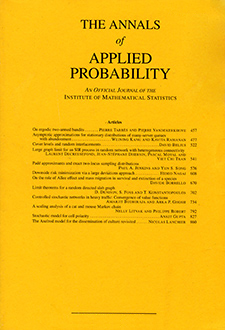Abstract
We extend the spatial $\Lambda$-Fleming–Viot process introduced in [Electron. J. Probab. 15 (2010) 162–216] to incorporate recombination. The process models allele frequencies in a population which is distributed over the two-dimensional torus $\mathbb{T} (L)$ of sidelength $L$ and is subject to two kinds of reproduction events: small events of radius $\mathcal{O} (1)$ and much rarer large events of radius $\mathcal{O} (L^{\alpha})$ for some $\alpha\in(0,1]$. We investigate the correlation between the times to the most recent common ancestor of alleles at two linked loci for a sample of size two from the population. These individuals are initially sampled from “far apart” on the torus. As $L$ tends to infinity, depending on the frequency of the large events, the recombination rate and the initial distance between the two individuals sampled, we obtain either a complete decorrelation of the coalescence times at the two loci, or a sharp transition between a first period of complete correlation and a subsequent period during which the remaining times needed to reach the most recent common ancestor at each locus are independent. We use our computations to derive approximate probabilities of identity by descent as a function of the separation at which the two individuals are sampled.
Citation
A. M. Etheridge. A. Véber. "The spatial $\Lambda$-Fleming–Viot process on a large torus: Genealogies in the presence of recombination." Ann. Appl. Probab. 22 (6) 2165 - 2209, December 2012. https://doi.org/10.1214/12-AAP842
Information





